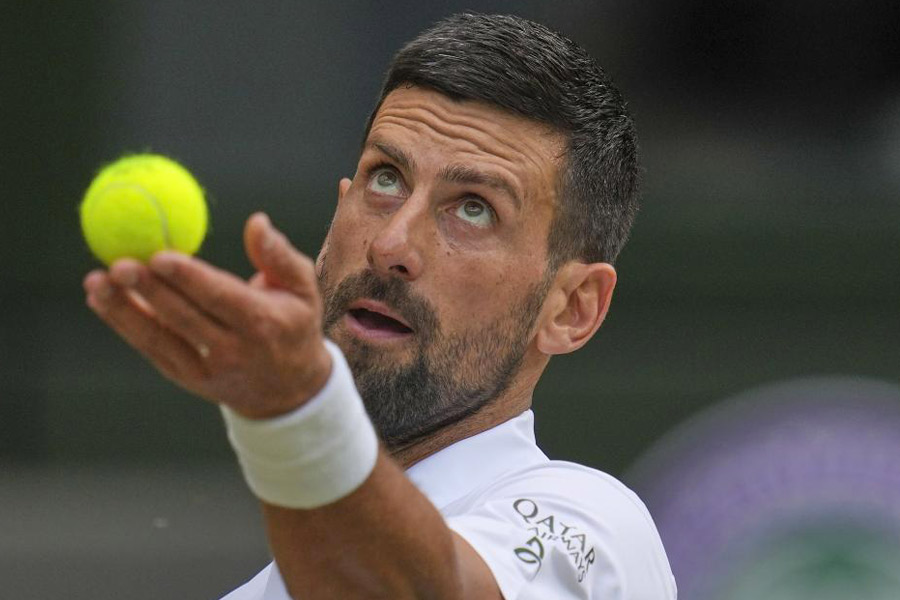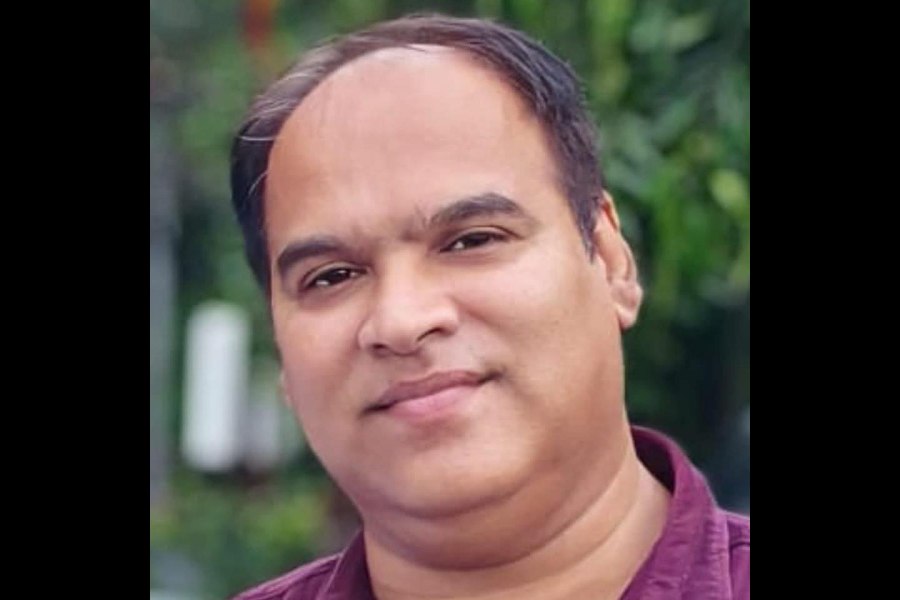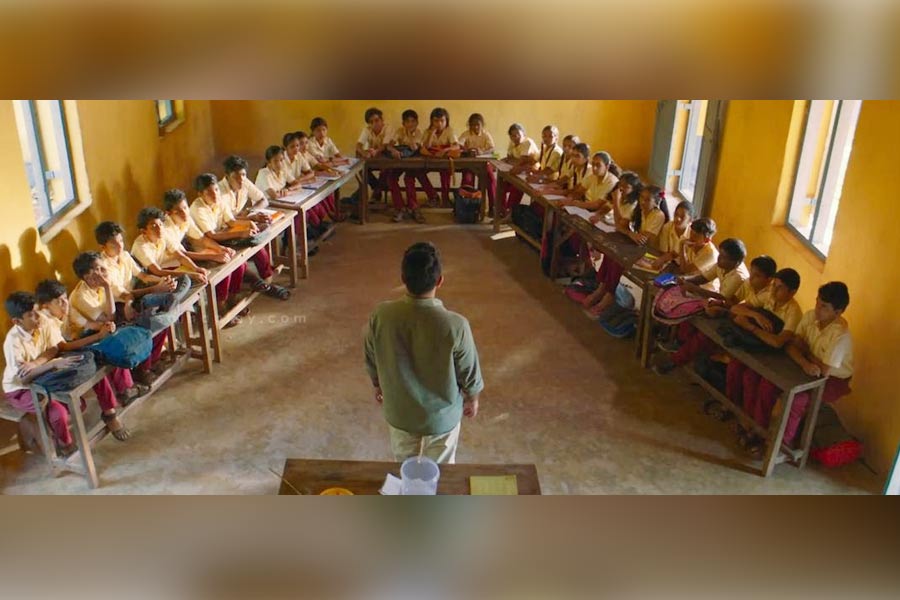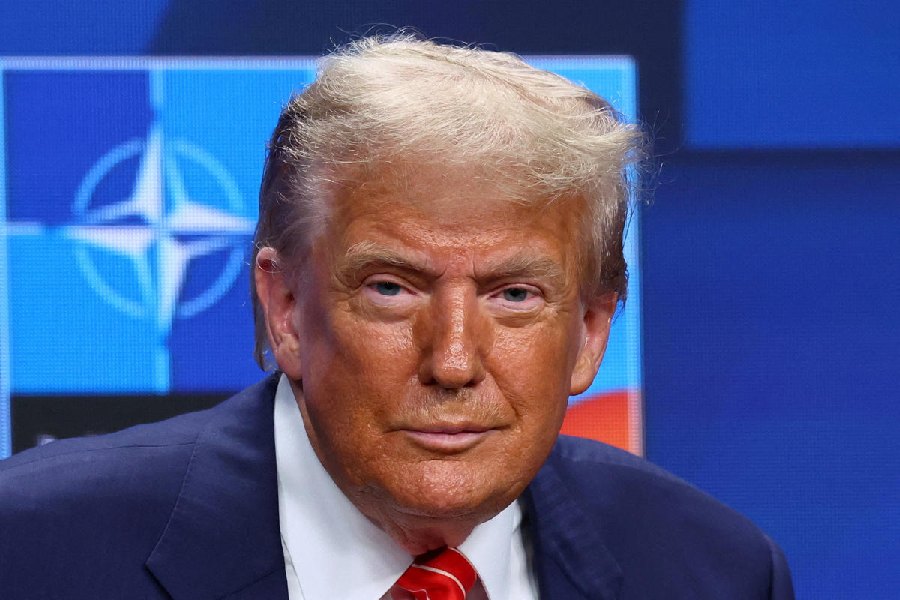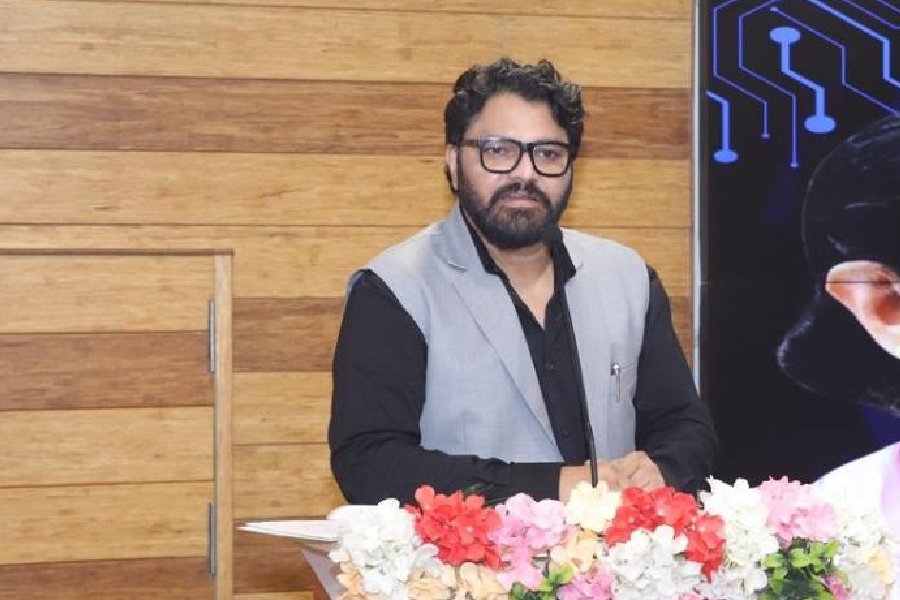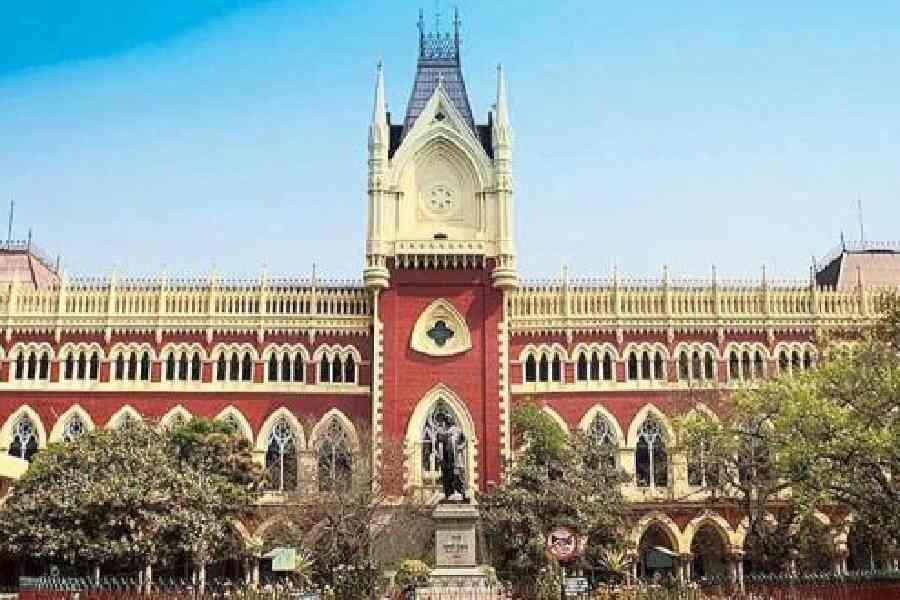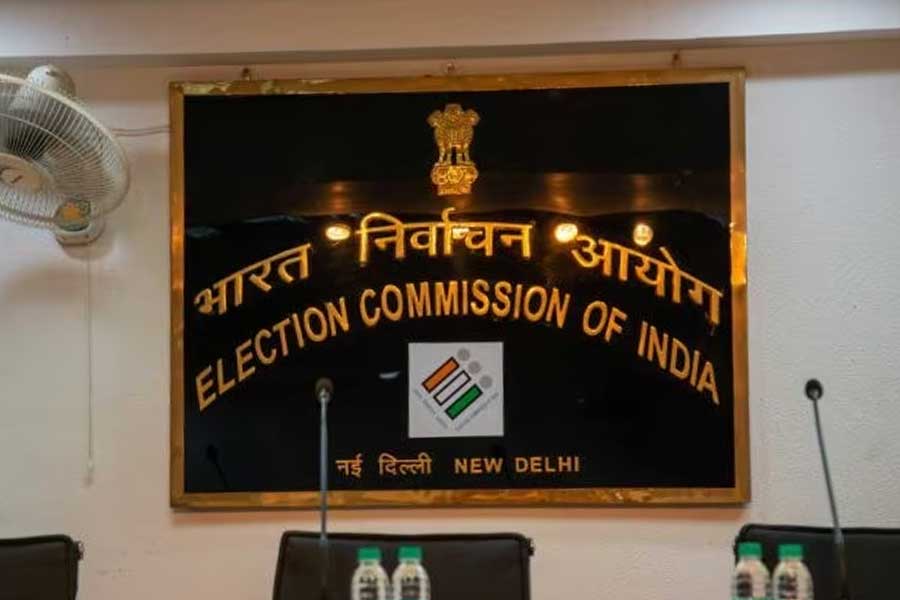 |
 |
Prabir Roy Chowdhury Purbachal, Cluster IX
Age on I-Day: 11 years
I was in Class VIII then, living with my uncle in the railway quarters of Salkia, Howrah, and studying in Hindu School, Salkia. My parents stayed in Jamshedpur. My friends and I used to compete in tracking how many gunshots we heard each day. Gunshots were a regular affair. A week before Independence, a riot broke out in the colony. That morning, I heard so many gunshots that it was tough to concentrate on my studies. The railway colony had a majority of Muslims. My uncle feared that we would be attacked anytime. We decide to seek shelter in a local doctor’s nursing home. Doctors were highly respected by both communities. It was quite a distance from our quarters. On our way, we saw two Hindus getting stabbed with spearheads. We had nearly reached the place when we got surrounded by Muslims. Suddenly, a voice behind us shouted: “Chhor do inko! Hamara aadmi hai!” It was my neighbour, Shirazda. He used to help me with history. With his help, we escaped and took shelter at the nursing home. My uncle hid me in the Sorting Yard Cabin where I stayed for two whole days, after which he decided to send me away to Boichi, the village pad of his friend, till normalcy returned. I had no clothes, except for the shorts and the shirt I was wearing. They gave me a dhoti to wear. It was tough adjusting there, especially because I knew no one. But at least, there was peace.
Two days later, my uncle sent a letter, asking me to come back. On August 15, the kids’ section called Chhotoder Pattari of the newspaper Jugantar had decided that children would be taken around Howrah in a truck. On the way, some Muslims stopped us and asked us to come down from the truck. I was shaking in terror. But to my surprise, they hugged us and gave us sweets. On the way, another group stopped us and played Dol with us. So, August 1947 brings back memories of both hatred and love.
 |
Panchkari Mukherjee HB Block
Age on I-Day: 14 years
We stayed in Jessore then. My father was the headmaster of the government school where I studied. Watching gora sahibs was a regular affair, especially in 1944 when the World War broke out in those parts and the American troops came alongside the British and the Indian soldiers. They turned the school into their barrack and my father had to vacate his quarters and we shifted to a rented house.
It was a common prank for children to shout “Yankee” on seeing the Americans and hide in the roadside bushes. Once an older boy was passing a military vehicle on his cycle. God knows what it was that he said. The goras came out, caught him by the collar and dragged him to the barracks. He came out after getting a sound thrashing.
When Direct Action Day (riots) happened in Calcutta on August 16, 1946, we realised independence might be imminent. Shyamaprasad Mukherjee came to Jessore and held camps where we were taught to defend ourselves in sword fights and lathi khela. The atmosphere in August 1947 was so vitiated with communal tension that there were hardly any celebrations worth remembering. At night, cries of Allah ho Akbar kept us awake. My father procured two swords. He used to sharpen them and say that if we were attacked by infidels, he would kill us rather than see us get killed. In September, we shifted to Krishnanagar, Nadia.
 |
Asutosh Mookherjee, AE (Part II) Block
Age on I-Day: 14 years
I was studying in Class IX, Ramakrishna Mission. We students used to wear Netaji caps sold for Re 1 and imagine ourselves as Subhas Chandra Bose, our idol. Radio and newspaper were our only sources of information. We heard about the Great Calcutta Killings of 1946. The news made my relatives anxious. My elder brothers and some cousins used to stay in Calcutta at my maternal uncle’s place near Jorasanko for studies. It was not safe to walk in the streets at daytime. My uncle’s tenant Kochi Mian helped my brothers and cousins escape from Uncle’s place and reach Howrah station from where they took a train to Asansol.
Nevertheless, when independence was declared, we were elated. We were told in school that there won’t be any classes but we would bring out a procession. Dressed in our uniforms, we marched through the neighbourhood, wearing Gandhi caps. Some sang patriotic songs. During the procession, we shouted slogans like Bharat Mata ki jai and Vande Mataram. After the procession, our head sir hoisted our national flag. Laddus were distributed. After school, with some of my classmates I roamed the streets to witness the celebrations. Shops were decorated. All the newspapers published special editions. My mother cooked our favourite dishes.
 |
Col. Dipti Bhusan Das Bhowmik BE Block
Age on I-Day: 18 years
When independence was declared, I was a student of Scottish Church College. My friends and I joined the revelry on the streets. Everyone was singing, dancing and waving the national flag. But one man stopped me to ask what the hue and cry was about. When I told him it was for our independence, he asked me what that meant.
I grew up in Shimla and Delhi, both important cities in the freedom movement. Leaders like Gandhi, Nehru, Badhshah Khan, Bhulabhai Desai, J.B. Kripalani and Sarojini Naidu would frequent Shimla for negotiations with the British and I would go and listen to their public meetings. I took all their autographs too, except for Gandhi. That’s because Gandhi would charge Rs 5 to give his autographs (the money would go to the welfare of the Harijans) and as a schoolboy I didn’t have that kind of money. But I have walked with Gandhi and even at that age, he would walk very fast.
| break of a new dawn |
 |
| The first page of Anandabazar Patrika |
Lots of political meetings in Shimla would begin with a chorus of Jana Gana Mana and we, Bengali boys, would invariably be called to take the lead.
Then again in Delhi, I took part in the 1942 Quit India movement. We school students headed to what is now the Rashtrapati Bhavan to protest, only to be chased out by the guards. That was the beginning and end of my political career.
Though the lifestyle of the common man did not change after independence, perhaps the whole affair influenced me subconsciously to join the Indian army a few years later.
 |
Samares Bandyopadhyay DL Block
Age on I-Day: 8 years
August 15 brought us sad tidings. We lived in Rangamati near Chittagong. At the news of Partition, my father decided that we had to leave. We left within a few months. We thought we would board the Goalanda Steamer and take a train that would bring us to Sealdah station in two days. But the steamer had been grounded.
This made us hitchhike though road, water and rail routes. Our packed train halted at a station and a lady in the next compartment casually let her hands out of the window. Her hands were full of ornaments. A screaming man came running from the station and chopped off her hands with a sword. The lady shrieked but her voice was drowned by the war cry of many more armed men who charged at the train with iron rods and daggers. They looted, took away women and killed anyone who resisted. They entered our bogie too but by god’s grace did not harm us. Thereafter we spent much of our time hiding amid jaggery containers in the train. And every time a station would arrive passengers would rush to push against the doors to keep them shut.
Before leaving Chittagong, we had informed our Calcutta-based aunt that we were coming. Expecting us to reach in two days, she kept going to Sealdah station at the scheduled arrival time of East Bengal Express everyday to receive us. The bogies that would reach the city would be bathed in blood and my aunt would have to look through the bodies to see if we were among them.
We finally reached Calcutta after 16 days, miraculously alive. The day we reached Calcutta, it was Sashthi. The city that would be our new home was busy celebrating its biggest festival.
 |
Gulrukh Taher DL Block
Age on I-Day: 10 years
I was a school student living in Krishnanagore. My father Fazrul Rehman was a freedom-fighter and many Congress leaders at that time used to come to our house to hold discussions.
On August 15, 1947, my school declared a holiday for four days. The national flag was hoisted by the senior-most resident of our neighbourhood. Patriotic songs were sung in Bengali and Hindi. Sweets were distributed. At night houses were decorated with candlelights as if on Diwali to usher in happiness and peace. It was a festival in the true sense of the term.
 |
Mihir Biswas BF Block
Age on I-Day: 14 years
We had to hoist a Pakistan flag in my front yard on August 14. We hail from Mymensingh in Bangladesh and on the day firecrackers were burst there. I had mixed feelings about the whole thing. I was happy the British were leaving but the partition was uncalled for. While I didn’t join the revelry, the government had forced every house to hoist the Pakistan flag. Either way I think Mymensingh was one of the few pockets in the country that had not broken into riots over the partition.
 |
Makhan Lal Deb BE Block
Age on I-Day: 8 years
I have no specific memory of August 15, 1947. That’s because in those days every day was spent cowering in some corner of the house and praying that we live to see one more day.
We lived in Sylhet, a district that had started witnessing communal tension from the mid-1940s. By the time we got independence, the three young boys in my family — my elder brother, my cousin and myself — had got targeted for being the scions of our huge family business.
I remember coming out of the bath one day and getting dressed when a reflection in the mirror made my hair stand on edge: a mob was stabbing people outside my house and setting them ablaze. I was six.
Things got worse by the day and we soon had to hide from the mobs in different places of our village every night. We had a domestic help whom we called Chacha and he would tip us off about his community’s movement.
 |  |
| Vignettes of celebrations on the streets of Calcutta on August 15, 1947 | |
One night we hid in our neighbour’s house as it had already been looted before and so we thought it would be safe. But they came again. My brother covered my mouth with his hand so I wouldn’t let out a sound and our neighbour somehow managed to send the mob away by saying there was nothing left to loot and no one left to harm.
The next night we hid in a cowshed. Again they came to look for us but we escaped. On the third night we hid in a dried-up canal and covered ourselves with bamboos. They walked over us and I could see their swords shining in the moonlight from between the spaces in the bamboos.
Finally Chacha made arrangements to sneak us off to Shillong, where we had our business establishments. We split the family in three groups. I went with my brothers. As we fled, I carried a little green sack (putli): the sum total of my childhood.
The family reunited in Shillong and once the situation normalised, Chacha visited us. He was so relieved to see us safe that he broke down in tears. Chacha had always been respected by us but back in Sylhet, he would not be allowed to sit inside our house or use the same hookah. The same man had saved our lives.
 |
Mariam Wali CL Block
Age on I-Day: 11 years
My grandfather Ameenuddin Ahmed strongly supported the Quit India movement and would even host Gandhi at our Harish Mukherjee Road guesthouse for bhajans. But none of us was prepared for partition and its aftermath.
We lived in Bhowanipore during the 1946 riots. I remember I was playing with my cousins on our terrace one afternoon when we noticed the sky overhead darkening with smoke billowing from the west. Before we could figure out what was happening we saw a man stumbling towards us from the same direction crying: “They’ve set fire to Kajipara…they’re killing everyone!”
The man was bleeding profusely and was being chased down by men with daggers in their hands. I still get nightmares of this horrific scene. Later on I heard that that man, the imam of our mosque and 15 to 20 other men who had gone to pray, had been chopped to pieces by miscreants. I use the word “miscreants” here as miscreants do not have a religion.
This other night when the situation was tense, a neighbour, A.K. Chanda sheltered around 40 of us from the angry mob. The next day the police escorted us to my uncle’s house in Park Circus. I saw countless bodies lying on the streets that day.
My uncle lived in the building that now houses the Charcoal Grill restaurant. We entered to find that he was already sheltering around 20 Hindus there. There was even a baby among those hiding and he wouldn’t stop crying. We had to send the mother and baby to the attic so his cries were inaudible to the mobs.
Food was short and I remember being served quantities like a teaspoon of rice for lunch. We stayed cooped up for a few days like that.
The joy of independence was slaughtered by partition. Two-thirds of my relatives left for Pakistan — some east, some west — but my father chose to remain in India as a proud Indian.
Gauri Sankar Chakravarty BJ Block
Age on I-Day: 12 years
On August 14, I was trembling with fright inside my house in Sylhet as the mob ran amok outside swearing to kill us all. I don’t remember any influence of the British on our lives but I remember seeing warplanes flying overhead during WWII. And the British-induced famine was terrible. I remember staging a play in 1943 in which I played a famine-stricken beggar. But more than the British rule, we were affected by partition. Nobody was spared. I remember I learnt two new English words at that time: plebiscite, with reference to Kashmir, and referendum, which happened in Sylhet after it was given off to Pakistan.
My family fled to Karimganj in Assam where we saw refugees treated like parasites. We survived but I saw many other once-well-off families pleading with tea garden labourers for some space in their houses or some food to eat. Many starved to death or died of malaria.
 |
Jyotirbhushan Dutta DL Block
Age on I-Day: 8 years
I can never forget Independence Day 1947. It was the only day I saw my father crying.
My father, Bibhutibhushan Dutta, was a freedom fighter. I grew up watching him enforce Gandhi’s swadeshi movement, burn British clothes, organise pickets and go to jail countless times. In fact once someone had asked me what my father did for a living and I had told him “Baba jail khatey.”
I woke up on August 14 and saw Faridpur come alive. People were singing on the streets, bursting firecrackers and shouting “Vande Mataram”. Just when I thought Independence was a happy occasion I stepped into my parents’ room and saw my father howling inconsolably. My mother was trying to comfort him. My father was a brilliant student who had left everything to fight the British. With partition, his world had come crashing. That day I was utterly confused. I couldn’t understand how the same occasion could make a city celebrate but my father cry.
 |
Jyotirmoyee Nag BA Block
Age on I-Day: 18 years
On August 15, 1947 I was a month-old bride in Chandpore, near Chittagong, trembling in fear of what new atrocities the partition would mean for us.
About two years before that I had been to hell and back. The village we lived in was getting torched every night and anyone caught trying to flee was getting butchered. We had nowhere to run. So we swam.
The area we lived in had lots of waterbodies and so one night I crept out of the house and swam to a safe neighbourhood. An uncle went with me. As we swam we saw the two banks go ablaze. The walls of the tin houses were falling like packs of cards and the fire was spreading to the forests around.
That same night, goons went to the house I had left behind and tried to stab another uncle. Our Muslim domestic help saved him. He lied to them that his daughter was married to my uncle and that she would be widowed if he was killed. They let him go. Later that night our help gave his lungi, skull cap and gamchaa to my uncle and helped him escape.
The next year, I got married and after independence my husband, who had a government job, got transferred to Behrampore. By then, the madness had mellowed down. But at its peak refugees were being housed in Chandpore’s schools and colleges. The steamers and trains to India would not ask refugees for money. At Sealdah station, trucks from Ramakrishna Mission and Bharat Sevashram Sangha would pick up refugees and take them to camps.
 |
Kamoda Kanta Majumdar Labony Estate
Age on I-Day: 32 years
I was a lecturer at Central Calcutta College or Islamia College in 1946. Trouble started when goons looted two gun shops at Harrison Road. What followed next is the Great Calcutta Killings that claimed lives in both communities. Closer to my hometown Rajshahi, the Noakhali communal riots had broken out. It was no longer possible for Hindus with daughters to continue living in communally sensitive neighbourhoods. I decided to permanently leave Rajshahi, and settle in Calcutta.
I remember an elderly man from Noakhali coming to Hooghly College to meet my colleague K.C. Roy at his residence. He was bewildered and wept inconsolably. The rioters had butchered his family, including two grown-up daughters. He had managed to escape and come to Calcutta.
On August 15, 1947, I had gone over to Rajshahi. My seven brothers along with their families and my mother sat in front of a radio to listen to the news of the partition. As Rajshahi was a Hindu-dominated region, we thought that it would be a part of India and Murshidabad which is Muslim-dominated would be in East Pakistan. But that didn’t happen. On hearing the sad news, we realised that it would be impossible to stay on. An elder brother who was a renowned doctor refused to leave Rajshahi. But within one year things came to such a pass that he too was forced to leave.
 |
Dhirendra Nath Chakravarti DL Block
Age on I-Day: 10 years
We shifted base from Faridpur, East Bengal, to Salkia in 1942. I got admitted to Salkia Anglo Sanskrit High School. I was not aware of the meaning of Independence. But my teachers and my father told me that the white men would go away from our motherland. Only we Indians would stay in our country.
At that time, I was a member of a local club which planned a grand celebration on August 15. So a retired army official was engaged to teach us how to parade. We bought white shorts, shirts and shoes. The club purchased drums as well. We toiled to prepare ourselves for D-Day. Members who could sing were rehearsing too. On August 15, I woke up at 4am and by 6.30am we all assembled at the park. The programme continued for three hours with patriotic songs being sung and acrobatics shown. I took part in the march-past. Three of my friends carried posters of Netaji Subhas Chandra Bose, Mahatma Gandhi and Pandit Jawaharlal Nehru as we criss-crossed the locality before assembling again at the park where a big pandal had been erected. The Tricolour was hoisted and the senior club members shared their feelings and dreams on the podium. Sweets were distributed among us as well as the audience.
 |
Tapati Bose CF Block
Age on I-Day: 5 years
I spent August 15 on the terrace of our Chetla house, brickbats clenched in hands and with my back pressed against the wall. There were riots going on in the streets. There was either a temple or a mosque under our house — I forget which — and people were killing each other. We’re lucky they didn’t come to harm us.
 |
Gouri Mukherjee AC Block
Age on I-day: 20
I came to Calcutta in 1943 from Ranchi for my IA degree. After passing out from Asutosh College in 1945, I took admission in Victoria College near Rajabazar.
In 1946, when the riots broke out there was utter chaos all around. Once we heard a mob approaching us. My maternal uncle asked us to move upstairs to the terrace and be prepared with bricks to throw on anyone who tried to barge in. The situation was so tense that my father decided that I should not stay in the city any longer. So I had to quit Victoria College with a heavy heart as Ranchi did not have colleges for women but luckily that very year, co-education was introduced.
On August 15, 1947 when the clock struck midnight we had celebrations at Morabali Pahar in Ranchi. Since I was good at singing, I was called to lead the National Song. Sweets were distributed. The celebrations continued but being a girl I had to get home early.
Later, I saw British troops leaving in trucks and I really enjoyed watching them go even though my father kept ordering me to get inside.
 |
Basanti Bhowmik BE Block
Age on I-Day: 12 years
The whole country was rejoicing in 1947 but it was a very sad occasion for me. We hailed from a joint family in Narayanganj, near Dhaka. Safety in the area had been consistently deteriorating so all the children of the house had been shifted to Calcutta in 1946 itself. Thereafter the elders were to shift but my father, NK Guha, was a renowned doctor there and neighbours wouldn’t let him leave. August 15 came and went. Everyone around me was celebrating but I was worried about my family. Then in 1951, my father told them my sister needed treatment in Calcutta and that he was going for a few days. He never went back.
 |
B.P. Kapoor FE Block
Age on I day: 16 years
With World War II underway, there was chaos. Calcutta was being bombed. Kidderpore and the Ganesh Talkies area were hit. The city would be deliberately plunged into darkness after sunset so that the Japanese bombers would not spot it. Cardboards shielded streetlights in a way that the glow was not apparent from afar. People pasted black tapes on their window panes to block the light in the rooms from filtering out.
The non-Bengali communities were leaving Calcutta for their native states. People were renting out their houses in the city for free as they needed someone to take care of their houses while they were away.
We would cross the Hooghly on horse-drawn carriages over a floating bridge to reach the station and a steam locomotive took us to Varanasi.
During my stay in Varanasi, I saw Mahatma Gandhi, Nehru and Madan Mohan Malviya at Banaras Hindu University. They had come for a convention. Nehru was a humble man. I remember someone touching his feet and he requesting him not to.
The divide and rule policy had ruined us. I saw people being killed in front of my eyes. There were areas where you saw tramcars full of bodies plying on either side. Things got worse when the riot-hit areas got flooded with bodies on the streets getting swollen in the water.
Yet independence was occasion for huge festivities. Processions were taken out everywhere. We ate a lot of tri-coloured sweets, called tiranga barfi. They used pistachios for green, cashews for white and saffron for saffron. Gandhi caps and Nehru jackets were extremely popular then. Even I got a Nehru jacket made. On August 15, 1947, flags were hoisted in all houses, shops, everywhere. I remember a boy dressed as Gandhi that day enacting something. Schools hosted programmes. People cried in joy.
 |
Ranajit Kumar Roychoudhuri AC Block
Age on I-Day: 31
A lot of youngsters ask if I have ever seen any freedom-fighter. “I am a freedom fighter,” I reply with a lot of pride. I had worked with the Jugantar party where young people like me were used to deliver goods and messages. We delivered packets which we were not supposed to open or know what was inside. We also had instructions not to say anything vital in Hindi or Bengali as a result of which we developed our own code language.
During World War II when the Japanese dropped their first bomb in Andhra Pradesh, I was studying at Banaras Hindu University. We were so scared that a few of us sought leave from the college authorities to go home. Benaras used to attract people from all parts of the country which is why it could be a target for the Japanese. However the college refused to declare leave.
We are from Chandiborpur in Jessore district. When the district magistrate used to come, we had to shout: “Long live the King.”
.jpg) |
I had started working before India became independent. Once, two of my bosses in suits were on a meeting to Jessore by road. On the way their car was stopped by locals who took them to be British representatives and gave them a public thrashing. I still remember how they walked into the meeting with torn ties and coats.
On August 15, 1947, we had office and I saw people leaving for processions with flags. We organised a small meeting in office where a few of us gave speeches followed by refreshments. The best thing about the day was the communal harmony. Despite the bloody riots barely a year back, Hindus and Muslims were celebrating together and that was what made me feel the happiest.
 |
Renuka Dutta BD Block
Age on I-Day: 18
I was brought up in Raghunath-ganj. My uncle was a freedom-fighter. Some-times he used to be away from home for days. Because of him, I could meet Netaji Subhas Chandra Bose. After a meeting, Netaji was passing by our house in a car and that was when my jethu brought him to our doorstep. I garlanded Netaji, handed over a pot of money to him on behalf of my uncle and touched his feet. I was just nine years old then but I clearly remember his face. Soon after, we heard the news of Netaji’s disappearance. We assumed that he was carrying on with his work from his hideout.
On August 15, 1947 there was so much happiness all around. We had no idea what would happen in future but at least the British would be leaving.
It was also a time of immense turmoil. For three days, Murshidabad became a part of East Pakistan. People were very scared and doors and windows of homes would be tightly shut. Only the elders used to leave home to shop for essentials. The situation was such that people who used to go outdoors to answer nature’s call had to think of alternatives for the sake of safety. Through the slits in lattices I remember watching soldiers marching down the streets. They were East Pakistani troops. At that point of time we were in a dilemma over Murshidabad being a part of India or not. The intervention of Gorkha troops gave us hope. But just to keep away from riots, the elders of our family decided to move away for a couple of months — first to Birbhum and then Puri. When we returned, things had settled down and we were glad to be a part of India.
 |
Sukla Gupta Purbachal Cluster IX
Age on I-day: 11 years
In those days, we lived in Sreeniketan. It was a part of Rabindranath Tagore’s Rural Reconstruction Project. Sreeniketan was smaller than Santiniketan. My father, an agriculturalist from Columbus University, and many other educated people from Calcutta were taken to Sreeniketan by Tagore himself to train village folk.
The salary was meagre but it did not matter. There was job satisfaction. The communities lived together in harmony. The Muslims were mostly poor and sold eggs, milk or vegetables. We heard about riots only on the radio.
When Independence was around the corner, we were told that we would no longer be ruled by the English. We started rehearsing for our performance on August 15. At the stroke of midnight, all the residents of Sreeniketan gathered for what we called Boitalik, which was singing and walking around. We sang Aamader jatra holo shuru as we walked.
Everyone went home at dawn but gathered again in the morning for flag hoisting. We kids had decorated the base of the flag staff with garlands. Patriotic songs were sung. In the evening, we were invited to a place near Bolpur station. We sang songs like Tomar potaka and then had dinner in the Santiniketan kitchen.
For us, children, the day had no special implication. We enjoyed ourselves like on any other festival. When we grew up, we used to look back to the day and smile, remembering that innocence.
 |
Bishnupada Jana AE (Part II) Block
Age on I-Day: 17 years
I took my matriculation examination in 1946 from Jogoda Satsangha Brahmacharya Vidyalaya at Moyna, now in East Midnapore. Then I came to Calcutta and got admitted to Vidyasagar College. I used to stay in Girish Park at a relative’s place. I was told by my relatives never to venture beyond Mahajati Sadan as it was a communally sensitive area and we would be killed if we set foot there. But that hardly kept bloodshed at bay. Armed with dagger and knives in hand, goons used to come in huge groups shouting “Allah ho Akbar”.
Every now and then we used to get news of acquaintances being killed. Sometimes they used to offer beef to passers-by as a test. Christians were spared. So on Independence Day, we stayed indoors as there was so much tension. There was hardly any celebration for us. But things started changing when refugees from East Pakistan started migrating to West Bengal in large numbers. They were daredevils and fought back when attacked.
Kakali Bose Eastern High, New Town
Age on I-Day: 7 years
I celebrated Independence Day in West Pakistan. My father was the curator of the natural museum in Karachi and my parents had been living there for 18 years. I remember waving at the beautiful Independence Day procession from our balcony.
Our house was on a very important road and I got to see the governor-general Mohammed Ali Jinnah, Viceroy Mountbatten and Lady Mountabatten passing in a horse-drawn carriage from my balcony. Lady Mountbatten was dressed like a queen and looked beautiful.
I don’t recall any British interference in our lives before that. My parents were both presidents of clubs in Karachi and we had an active social life. We welcomed independence and were ready to accept partition too. We had thought our lives would be the same thereafter but communal riots began and we had to flee, leaving everything behind.
Flights and trains were unsafe so we took a ship to Bombay. We knew no one there and put up at a langar. Eventually we moved to Bengal and started afresh.
 |
Mihir Kanti Basu DB Block
Age on I-Day: 21
I was a student of Taki Government School in Basirhat and I remember the excitement of watching warplanes fly over our school during World War II.
Later, I took admission in Asutosh College. Asutosh Mukherjee’s house was near my mamar bari. I saw Shyama Prasad Mukherjee a number of times and probably also caught a glimpse of Asutosh Mukherjee too during his last years.
On August 15, 1947, none of us slept. We went out and burst crackers. Processions were out on the streets waving flags. However, many were sad as their relatives were now in a different country called East Pakistan.
 |
Dilip Kumar Misra AA Block
Age on I-Day: 15 years
I was born in East Midnapore, famous for being a hub of freedom- fighters. They used to carry out their work in hiding. My mama himself was one and was arrested. He came out of jail in 1948, only after serving his term.
Due to Suhrawardy being the district magistrate, Urdu was made compulsory in our syllabus. I had to study Urdu from Class IV to VI along with Bengali, Hindi and English. Even shouting Vande Mataram in public could land one in jail.
During World War II, when the Japanese dropped a bomb in Hatibagan, we were in Maniktala. No doubt their target was the Kidderpore dock but it was fortunate that the bomb did not blast in Hatibagan. Still, my family members decided not to stay on in the city and we returned to our village. I also witnessed the effects of the famine which broke out during the war. People were out on the streets begging for gruel (fyan). There was no shortage of production. The famine happened because the crops were sent to feed the army.
When India became independent, students from classes V to X brought out a procession from our school, carrying flags. Being in Class 7, I remember we had left at around 9.30am and returned to school only after 4pm. We had covered five villages on foot carrying the flag and shouting Vande Mataram.
Alakananda Gupta CJ Block
Age on I Day: 10 years
I used to stay in Jessore, now in Bangladesh. Though I was in school at that time, I was politically conscious. Since Jessore was a Hindu-dominated region, we all thought that it would come under India. But we were wrong. Jessore went to East Pakistan.
The division was announced around that time so there was hardly any celebration for us. We stopped going to school, as there was a sense of insecurity amongst us. Everybody was sad as we knew that we would have to move to India, leaving everything behind. My father, an advocate, used to practise in Calcutta. He started searching for a house for all of us since we had a joint family. We moved to Calcutta in 1948 and resumed our studies.
Compiled by Brinda Sarkar, Aniket Sil, Sucheta Chakraborty and Shreya Chatterjee
Pictures by Mayukh Sengupta and Saradindu Chaudhury
What memories do you have of August 15, 1947? Write to The Telegraph Salt Lake, 6 Prafulla Sarkar Street, Calcutta 700001 or email to saltlake@abpmail.com


